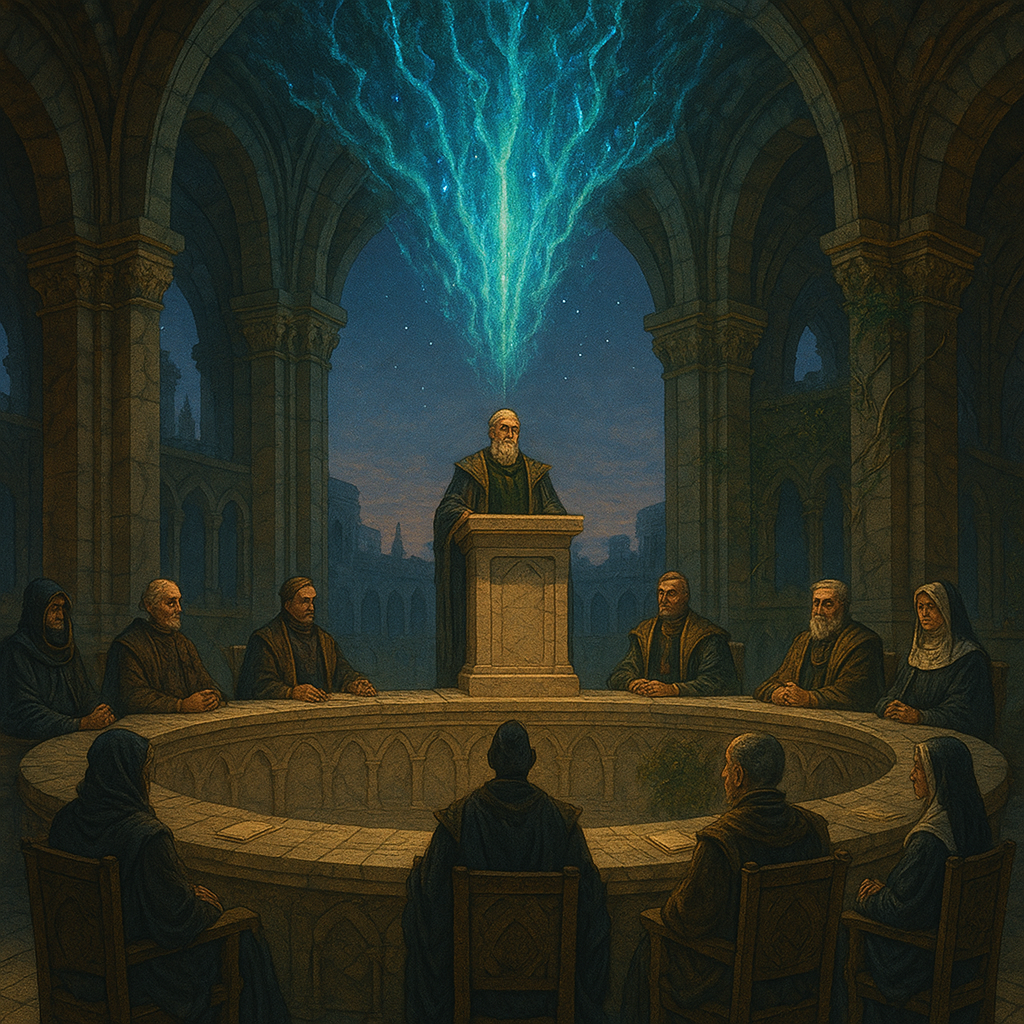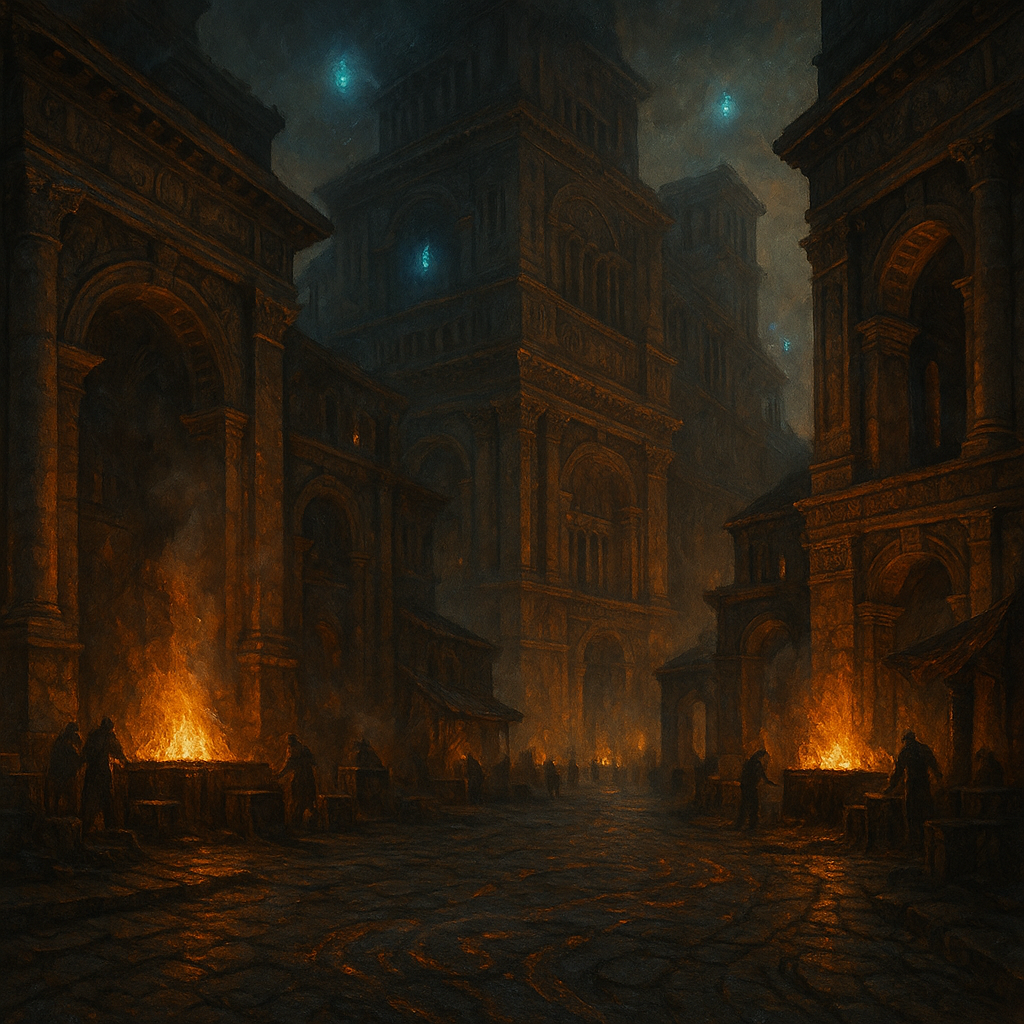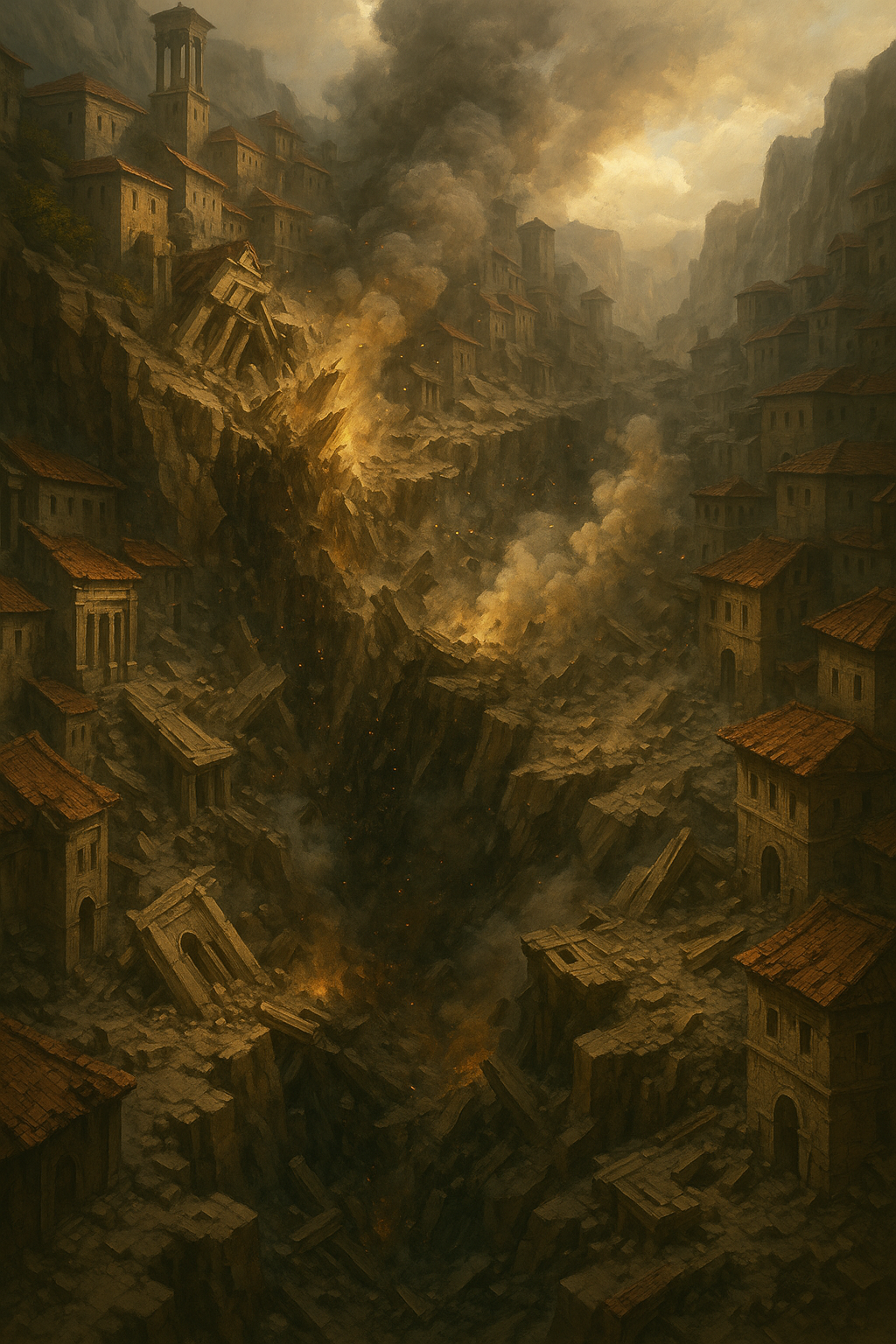Virelia
The City That Refuses to Fall
“We have buried our city three times, and each time she has risen brighter — as we shall, until the end of days.”
Virelia is more than stone and mortar — it is a living symbol of defiance and renewal. Time and again, it has been toppled by Rift storms, marauders, and its own hubris, yet each ruin became the foundation of a grander future. Streets paved with fragments of its past remind Virelians and visitors alike that even broken things can shine. Today, the city stands as a beacon of trade, scholarship, and Rift-born artistry, drawing people from across the Empire to marvel at its layers of history.
Demographics
Virelia’s population is a tapestry of cultures and origins, reflecting its turbulent yet welcoming history. The majority are Riftborn Romans, descended from the city’s founders, known for their luminous eyes, resilience, and mastery of craft. Imperials make up the next largest group — traders, scholars, and officials drawn by the city’s wealth and mystery. Dwarves from the Ashfang Range maintain a permanent enclave, their stonecraft evident throughout the city. Halflings and Riftwatchers add to the diversity, filling roles as scribes, healers, and guides. The Rift-born minorities are often interwoven with Imperial lineages, their hybrid heritage celebrated rather than hidden. Wealth and status here depend more on skill and reputation than on bloodline, though old Riftborn families still command respect.
Government
The Riftwatch Council governs with equal parts tradition, diplomacy, and pragmatism. Its chamber is composed of representatives from each major guild, noble family, and religious order, ensuring that no single faction dominates the city’s future. Council sessions begin at dawn in the Silent Court, with the Chairman presiding from a raised marble dais beneath a Riftlight canopy. Chairman Lucius Dharan is known for his patient moderation and ability to forge compromise among fiery voices. The Stone Tribunals — open-air courts where citizens may petition directly — are seen as a cornerstone of Virelian justice, emphasizing accessibility and transparency. Behind the scenes, power-brokering between guilds and quiet negotiations in the Veiled Crescent influence policy as much as the formal debates do. Virelians regard their government with a mixture of pride and wary humor, calling it “a forge where even ice can catch fire.”
Defences
Virelia’s defences are both an expression of engineering brilliance and a monument to its history of survival. Its outer walls are layered with Riftstone and reinforced with dwarven anchors, rendering them nearly impervious to siege engines and Riftstorms alike. The main gates are clad in aether-steel, their hinges etched with protective glyphs that shimmer faintly at dusk. Watchtowers stand sentinel along the walls, staffed with archers, Riftborn wardens, and sentry mages trained to repel both mundane and magical threats. Ballistae and enchanted lanterns are mounted atop the towers, capable of lighting up the valley or firing molten bolts into advancing foes. Beneath the city, an intricate labyrinth of tunnels allows for swift movement of troops, storage of supplies, and covert evacuation if needed. Even the cliffs themselves have been harnessed as a defensive weapon — avalanche triggers and collapsing stonework can be unleashed upon invaders should the outer defences fail. Every gatehouse and battlement bears scars of past assaults, now polished into proud symbols of defiance.
Industry & Trade
Virelia’s economy hums like the forge and glimmers like the Rift itself — a dynamic blend of craft, trade, and scholarship. At dawn, the Embers district roars with the sound of hammers striking enchanted stone and aether-thread looms weaving veils of impossible delicacy. The Shard Market becomes a carnival of commerce by midday, where Riftlight crystals are bartered alongside Imperial silks and rare herbs. Rift-born scribes and scholars, commissioned from afar, work deep within the Veiled Crescent’s libraries, illuminating manuscripts or crafting magical contracts. Trade caravans and merchant galleys arrive daily, bringing grain and wine from the plains in exchange for Virelia’s unique exports: veils of solace, Riftlight talismans, and enchanted architectural stone that glows faintly at night. Even the city’s own ruins are mined — ancient carved stones and shattered Rift-crystal shards sold as relics to pilgrims and collectors alike. Industry here is both sacred and practical: each craft performed with the knowledge that it preserves the legacy of a city that has endured everything thrown against it.
Infrastructure
Virelia’s infrastructure is both a testament to its survival and a showcase of ingenuity. Beneath its streets lie multiple strata of engineering: aqueducts that carry Riftwater into public fountains and baths, underground cisterns that store excess rain and springwater, and catacombs that double as shelters during storms and invasions. Streets are not merely cobbled but paved with slabs inset with Riftlight veins, ensuring safe passage at all hours. Aether-steel bridges link the city’s cliffsides and withstand both tremors and magical surges. Retaining walls reinforced with dwarf-carved anchors prevent landslides from the cliffs above. Public plazas are dotted with Riftstone lampposts, and drainage channels beneath the city carry runoff cleanly to the lake below. Entire neighborhoods are connected by covered arcades and tunnels that shield citizens from the valley’s harsh winds and sudden Riftstorms, making Virelia not just livable but welcoming in the face of adversity.
Districts
Virelia’s districts each tell a chapter of the city’s saga, woven into its geography like the layers of its rebuilt stones. The Shard Market sprawls at the city’s heart — a dazzling riot of banners, scents, and shouting merchants selling Riftlight crystals, enchanted veils, and Imperial silks side by side. Here, both trade and gossip flow like water. To the north lies the Silent Court, a solemn plaza of smooth stone where law is spoken beneath the open sky, its edges flanked by columns carved with the names of judges and chairmen past. The Veiled Crescent, curling along the cliffs, is the residential quarter where cascading gardens tumble down balconies lit by gentle Riftlight, and narrow streets echo with laughter and quiet song. To the south, the Embers rises from what was once ash — the industrial district reborn from the great fire, its forges roaring night and day, the air still faintly scented with cinders. Each district hums with its own rhythm, yet together they form the living heart of a city that refuses to die.
Assets
Virelia’s assets are as layered and enduring as the city itself. Its Riftlight crystal mines glow with veins of light coveted across the Empire, while carefully tended cliffside gardens and herb terraces produce rare plants used in medicines and rituals. Artisan workshops scattered through the Veiled Crescent and the Embers turn out enchanted textiles, carved talismans, and delicate veils of aether-thread prized from Nova Roma to the Ashfang Range. The city’s libraries, some built directly into the walls of the cliffs, safeguard centuries of knowledge — legal records, Riftborn lore, engineering schematics — meticulously illuminated and cataloged. The Lantern Steps serve not only as a memorial but as an asset to Virelia’s prestige, drawing both pilgrims and scholars to its glowing terraces. Even its own ruins — integrated into walls, streets, and monuments — have become cultural and economic treasures, mined for both memory and meaning.
Guilds and Factions
Virelia’s guilds and factions are not merely institutions — they are the lifeblood of the city, shaping its culture, economy, and politics in ways both open and clandestine. The Riftborn Weavers’ Guild occupies the luminous Veil Hall, where generations of artisans spin aether-thread into veils that symbolize dignity and defiance. Their influence extends beyond cloth, weaving connections between noble houses, merchants, and shrines alike. The Stonewright’s League, headquartered in the Embers, is as much an order of engineers as a fraternity of philosophers; its members see every wall, bridge, and tunnel as a prayer made permanent. The Riftlight Miners’ Guild maintains strict control over the shimmering crystal veins below the city, guarding their secrets fiercely while ensuring steady trade. High upon the cliffs, the Basilica Arcanii chapterhouse hums with quiet power — scholars and magi poring over ancient Rift-born texts and advising the council from the shadows. And in the quiet alleys of the Veiled Crescent, the Silent Crescent cult whispers its rites to the Rift, a hidden hand among the stones. Together, these factions form a tapestry of competing ambitions and intertwined loyalties, each vital to Virelia’s survival and splendor.
History
Virelia’s history is a saga of survival etched into stone and memory. It began in Year 12 AR, when Cassian Marcellus and Thalvia Ysera led Imperial and Riftborn refugees to this fertile valley after fleeing the Rift’s devastation. They raised crude walls and sanctuaries, carving out a fragile hope among cliffs and storms. During Chairwoman Claudia Varro’s rule, the city endured its first cataclysm: a Rift storm in 47 AR flattened the nascent settlement, yet the survivors — with aid from Ashfang dwarves — rebuilt it stronger, fortifying it with Riftstone and dwarven anchors. In 139 AR, during Chairman Gaius Tharix’s tenure, marauders descended from the hills during the chaos of the Ashfang Campaign and sacked Virelia, yet its defenders held the Silent Court long enough for the Riftwatch Council to regroup and reclaim it. By 306 AR, under Chairwoman Vetra Aurelia, decades of over-mining caused the mines to collapse, swallowing whole streets into the depths. But even this ruin became part of its rebirth — the shattered layers integrated into new foundations, and memorials carved from the very stones of its scars. Every rebuilding added another story, another testament to its defiance. Virelia’s history is not just a record of survival, but a celebration of the city’s refusal to vanish — each generation building higher on the bones of the last.
Points of interest
Virelia’s points of interest capture its long, layered story and the splendor of its survival. At dawn, the Silent Court gleams with Riftlight, its polished stones carved with the laws and names of past rulers — the open-air plaza where justice has been spoken for centuries. The Shard Market is a kaleidoscope of Rift-born wonders and Imperial luxury, its stalls draped in glowing silks and its air thick with incense and laughter. Climbers come to the Lantern Steps, a terraced memorial where each step is hewn from the ruins of earlier cities and lit with Riftlight lanterns that glow like constellations at night — pilgrims leave offerings there to honor ancestors or make vows. The Veil Hall, home to the Riftborn Weavers’ Guild, is said to shimmer like water when dusk falls, its drapes of aether-thread whispering in the wind. Hidden beneath the city, the Catacomb Gardens — a quiet sanctuary of bioluminescent moss and carved memorials — offer solitude to the mourning or the meditative. Each site is not just a destination but a chapter in Virelia’s unbroken song of defiance.
Tourism
Virelia draws visitors like moths to flame — pilgrims, scholars, merchants, and wanderers alike find reason to come. Pilgrims climb the Lantern Steps to leave offerings or inscribe their own names on small stones set into the terraces, hoping the city’s tenacity will bless them with strength. Scholars spend seasons in the cliffside libraries, pouring over Riftborn texts and illuminated manuscripts, often joining debates in the Silent Court or attending lectures in the Basilica Arcanii. Merchants crowd into the Shard Market, drawn by the unrivaled Riftlight crystals, enchanted veils, and rare herbs. Even artists and poets make the journey to capture the sight of Riftlight veins glowing across marble streets at dusk. Inns carved into former fortifications offer not only rooms but stories — each more colorful than the last — and the experience of sleeping in chambers that once sheltered defenders during the city’s many sieges. Visitors often speak of leaving Virelia with heavier purses, fuller hearts, and a quiet determination they hadn’t known they possessed.
Architecture
Virelia’s architecture is nothing short of a love letter to endurance. Imperial order meets Rift-born fluidity in every facade: stately marble colonnades are etched with glowing glyphs that ripple softly at dusk. Arched bridges link cliffsides, their underbellies inlaid with shimmering crystals that light the water below. Balconies of the Veiled Crescent overflow with gardens that spill down the cliffs in a cascade of green and color, while the Embers bristles with proud forges beneath smokeless chimneys that glow faintly from within. Glass floors in public halls expose layers of ruin beneath — older walls, cracked streets, and ancient inscriptions laid bare as reminders of the city’s scars. Doors are often framed with veils or lanterns, softening their austerity. At the heart of the city rises the Silent Court, its pillars polished smooth and inscribed with the laws of centuries past, open to the Rift above. To walk through Virelia is to walk through history and see it alive in every brick, every arch, every flicker of Riftlight.
Geography
Virelia rests where the jagged cliffs of the Riftwatch Escarpment meet the fertile Riftwatch Valley, a natural amphitheater that cradles the city in stone and green. To the east, the cliffs rise sheer and imposing, their faces streaked with Riftlight veins that glow faintly at night. Terraced gardens climb these cliffs, spilling color down toward the lake below. Westward, the valley opens to rolling fields dotted with shrines and farmsteads. Beneath the city, a shimmering Rift-fed lake mirrors both the stars and the Rift’s strange glow, its clear waters feeding springs and fountains. The city’s layered foundations are so integrated with the landscape that its streets seem to flow with the contours of the earth, blending stone and nature seamlessly.
Climate
Virelia’s climate is a study in contrasts, shaped by the Rift and the mountains around it. Winters are crisp and dry, with Rift storms sweeping through the cliffs to scatter snow that sparkles faintly in the Riftlight. Summers are warm but tempered by cool valley breezes and the shade of the escarpment. Spring arrives in a riot of bloom, the cliffsides erupting with wildflowers and the terraces humming with life. Autumn brings a golden hush to the city as the Rift’s glow deepens and the valley mists creep in. Throughout the year, occasional Rift storms lend the city an unpredictable but magical atmosphere — their light and wind turning even the familiar streets into something wondrous and strange.
Natural Resources
Virelia thrives on the bounty of both valley and Rift. Its most prized resource is the Riftlight crystal, harvested from veins running through the cliffs and sold throughout the Empire as both ornament and magical reagent. Fertile soil in the Riftwatch Valley produces herbs, grains, and fruits, while cliffside gardens grow rare medicinal plants used in rituals and remedies. Beneath the city, fresh water springs bubble from the Rift-fed lake, sustaining the population and filling its fountains and baths with crystal-clear water. Quarries yield marble streaked with Riftlight veins, used in Virelia’s distinctive architecture and exported as a luxury material. Even the remnants of past ruin — shattered Rift-crystals and ancient carved stones — are collected and sold as charms, relics, and building materials, turning the scars of destruction into treasures for the future.






Comments